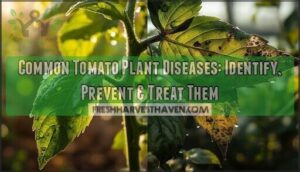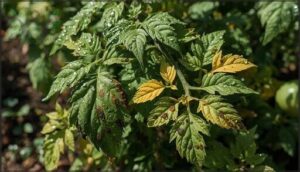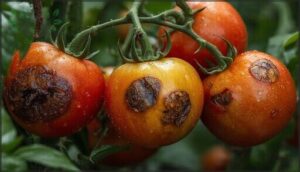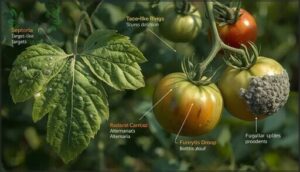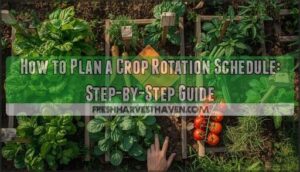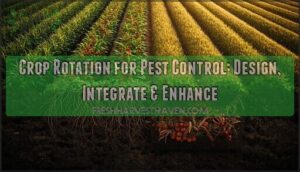This site is supported by our readers. We may earn a commission, at no cost to you, if you purchase through links.
Your tomato plants looked perfect yesterday. Today the lower leaves show dark spots ringed like a target. That’s early blight making its move.
Tomato plants face dozens of threats from fungi, bacteria, viruses, and environmental stress. Each common tomato plant disease leaves distinct calling cards on leaves, stems, or fruit. Some spread through wet foliage. Others attack through contaminated soil or insect carriers.
The key to saving your crop is catching these diseases early and knowing which treatment actually works. Recognition beats guesswork every time.
Table Of Contents
- Key Takeaways
- Common Fungal Diseases in Tomato Plants
- Bacterial and Viral Tomato Diseases
- Soilborne and Physiological Tomato Disorders
- How to Identify Tomato Plant Diseases
- Prevention and Management Strategies
- Frequently Asked Questions (FAQs)
- What is the most common disease in tomato plants?
- How can I tell what’s wrong with my tomato plants?
- What temperature conditions trigger most fungal diseases?
- How long do soil-borne pathogens survive?
- Can diseased tomatoes be safely eaten?
- Which diseases spread fastest between plants?
- Do greenhouse tomatoes get different diseases?
- Can infected tomato plants recover without treatment?
- How long do disease spores survive in soil?
- Are heirloom tomatoes more susceptible to diseases?
- Conclusion
Key Takeaways
- Early detection is critical because many fungal diseases like early blight and late blight can reduce yields by 20-80% within just days once conditions turn favorable.
- Prevention through crop rotation, proper spacing, soil-level watering, and disease-resistant varieties cuts disease pressure more effectively than treating infections after they appear.
- Visual diagnosis requires identifying specific patterns—fungal diseases show concentric rings or fuzzy growth, bacterial infections create dark vascular streaking, and physiological disorders like blossom end rot stem from calcium deficiency rather than pathogens.
- Soilborne pathogens like Fusarium and root knot nematodes can survive in soil for years, making sanitation, debris removal, and rotating away from nightshade relatives essential for breaking disease cycles.
Common Fungal Diseases in Tomato Plants
Fungal diseases are some of the most common problems you’ll face when growing tomatoes. They thrive in warm, humid conditions and can quickly spread from leaf to leaf if left unchecked.
Here’s what to watch for so you can catch these infections early.
Early Blight Symptoms and Spread
Early blight starts as brown to black leaf spots with bull’s-eye rings on your tomato plant’s lower leaves. You’ll spot these tomato diseases from mid-July through August as spores spread by wind and water splash.
Disease symptoms worsen fast when temperatures hit 82–86°F and humidity exceeds 90%. This fungal disease can slash your yields by 20–80%, with leaf lesions expanding within just five days.
Early blight thrives in heat and humidity, spreading fast enough to cut tomato yields by up to 80% within days
To manage this issue, adequate nitrogen fertility can help delay disease development.
Late Blight Identification
Late blight hits harder than early blight and spreads like wildfire in cool wet weather. You’ll see tan or brown greasy-looking leaf lesions with white fuzzy growth underneath. These fungal disease symptoms appear on young leaves first and quickly move to stems and fruit.
Dark sunken spots develop on green or ripe tomatoes while the fruit stays firm. As the disease progresses, you may observe watersoaked lesions appear on the leaves. This disease can wipe out your entire crop within days.
Septoria Leaf Spot Signs
Septoria leaf spot shows up as small round spots on your lower tomato leaves. Look for gray to tan centers with dark brown edges. The real giveaway is the tiny black specks inside each spot called pycnidia.
Early lesion appearance starts on older leaves and climbs upward. Leaf yellowing follows as spots merge together. Severe infections cause leaf drop and leave fruit exposed to sun damage.
Anthracnose on Fruit
Anthracnose strikes ripe or nearly ripe fruit with circular water-soaked spots that darken and sink inward. You’ll see concentric rings form as lesions grow to about half an inch across.
This fungal disease thrives in warm humid weather and can slash your harvest by 30%. The fungus hides in plant debris and soil. Infected fruit quickly becomes unmarketable.
Early fungicide applications help prevent spread.
Powdery Mildew and Leaf Mold
Unlike most fungal diseases that need wet leaves, powdery mildew spreads through dry air and high humidity. You’ll notice whitish powder on leaves and irregular yellow blotches. Leaf mold prefers wet foliage and creates pale spots that turn brown.
Both diseases thrive at 20–25°C and can slash yields by 33%. Early fungicide applications prevent economic losses and fungicide resistance.
Botrytis Gray Mold and Alternaria Stem Canker
When moisture hangs heavy in your greenhouse, Botrytis Gray Mold arrives uninvited. This fungal pathogen causes $10–100 billion in losses annually, showing gray fuzzy growth on dead tissue and ghost spots on fruit. Alternaria Stem Canker creates dark cankers with concentric rings near soil level.
Watch for these Gray Mold Symptoms and Stem Canker Conditions:
- Brown blighted leaves spreading to younger growth
- Dark sunken lesions girdling stems
- Gray-white soft rot on infected fruit
- Brown streaking in vascular tissue
Both fungal diseases need moderate temperatures and high humidity for Spore Survival. Environmental Factors like overhead irrigation worsen outbreaks. Disease Management combines sanitation with targeted Fungicides—though resistance is rising. Biological controls using Metarhizium reduce severity over 70%.
Bacterial and Viral Tomato Diseases
Bacterial and viral diseases operate differently than fungal infections but can be just as devastating to your tomato plants. These pathogens often spread through water, insects, or contaminated tools and can persist in soil for years.
Understanding the key bacterial and viral threats helps you catch problems early and protect your harvest.
Bacterial Speck and Bacterial Spot
Bacterial speck and bacterial spot are two bacterial diseases that can wreak havoc on your tomato plants. Bacterial speck thrives in cool, moist conditions between 55°F and 77°F, while bacterial spot prefers warmer temperatures from 75°F to 86°F.
Disease identification is important because both create dark lesions on leaves and fruit. The economic impact can be severe, with bacterial spot causing yield reductions up to 50%.
Control measures include copper fungicide applications and resistance management through crop rotation.
Bacterial Wilt and Southern Blight
Two soilborne diseases can stop your plants cold. Bacterial wilt attacks when temperatures climb above 85°F, with field incidence hitting 100% in some growing regions. Southern blight creates reddish-brown stem cankers at the plant base, reaching up to 70% incidence in untreated fields.
Here’s what you need to know:
- Wilt incidence averages 20.94% at the plant level in central tomato regions
- Blight symptoms include white-to-brown sclerotia on infected stems
- Biocontrol agents like Trichoderma reduce disease by up to 69%
- Economic impact is severe since methyl bromide restrictions began in 2017
Tomato Pith Necrosis
When cool nights and high humidity collide, Pseudomonas bacteria invade your tomato stems. Tomato pith necrosis shows up as brown, hollow chambers inside stems when the fruit reaches the mature green stage. You’ll spot stem swelling, wilting on one side, and dark lesions. Disease symptoms and causes link directly to excessive nitrogen and poor airflow in greenhouses.
Control strategies focus on prevention since copper fungicides can’t reach bacteria inside plant tissues.
| Aspect | Key Details | Management |
|---|---|---|
| Pith Necrosis Causes | Pseudomonas corrugata bacteria in soil | Remove infected plants immediately |
| Identifying Symptoms | Hollow stems, chlorotic leaves, adventitious roots | Monitor during fruit development stage |
| Favorable Conditions | Cool nights, warm days, high humidity | Improve air circulation, reduce nitrogen |
| Yield Impact | Reduced fruit size and number | Plant diseases controlled through rotation |
Mosaic Virus Effects
Mosaic virus attacks your plants through contaminated tools and infected seeds, spreading rapidly through mechanical transmission. You’ll notice light green mottling on leaves and distorted fruit that lose up to 25% of their market value.
Viral infections cause yield reduction between 2% and 10% annually, with severe cases reaching 20% loss. Early infection hits hardest, stunting growth and reducing your harvest considerably.
Yellow Leaf Curl Virus
Yellow leaf curl hits your plants when whiteflies transmit the virus during feeding. You’ll spot upward-curling leaves with yellow margins and stunted growth within three weeks.
This viral disease causes global economic losses reaching 100% in severe outbreaks. Resistance breeding offers your best defense since no chemical cure exists.
Plant resistant varieties to combat whitefly transmission and protect your harvest from devastating viral infections.
Soilborne and Physiological Tomato Disorders
Not every tomato problem comes from a pathogen you can see under a microscope. Some disorders stem from what’s happening beneath your feet in the soil, while others develop from environmental conditions your plants can’t escape.
Understanding these soilborne pests and physiological issues helps you address problems that won’t respond to typical disease treatments.
Root Knot Nematodes
Beneath the soil, root knot nematodes wage a silent war on your tomato plants. These microscopic parasitic roundworms invade roots and create galls that block water and nutrient uptake. You’ll notice stunted growth and wilting leaves above ground.
Economic losses from these soilborne diseases reach staggering levels globally. Control methods include crop rotation with non-host plants and nematode-resistant varieties carrying the Mi-1.2 gene.
Damping Off in Seedlings
While nematodes attack from below, fungal pathogens strike your youngest plants at soil level. Damping off targets seedlings during their most vulnerable stage, causing sudden collapse within days. You’ll recognize this fungal disease by dark, shriveled stems at the soil surface.
Overwatering risks and poor air circulation create ideal conditions for these fungi.
Preventing tomato diseases starts early—use biocontrol coatings on seeds, consider soil pasteurization, and apply fungicides when necessary.
Blossom End Rot Causes
Unlike fungal diseases that spread from plant to plant, blossom end rot stems from calcium deficiency in developing fruit. You’ll see dark, sunken lesions on the bottom of your tomatoes. This physiological disorder isn’t contagious—it happens when:
- Water stress disrupts calcium transport to fruits
- Moisture fluctuations prevent consistent nutrient uptake
- Environmental factors like high temperatures increase calcium demand
- Excess nitrogen interferes with calcium absorption
- Root damage reduces uptake capacity
Addressing blossom end rot requires steady watering and soil management.
Buckeye Rot and Gray Wall
Buckeye rot strikes when fruit touches wet soil. You’ll spot bull’s-eye pattern fruit lesions that decay rapidly. This disease caused 30-40% crop damage in India and market impact with doubled tomato prices.
Gray wall creates internal browning that’s often confused with other tomato diseases. Both fruit rot diseases reduce your harvest greatly.
Control efficacy depends on plastic mulch and proper drainage to prevent soil contact.
Sunscald and Environmental Stress
When intense sunlight hits exposed fruit, sunscald creates whitish patches that never ripen properly. Heat stress and waterlogging effects can reduce your tomato yield by up to 52%. Environmental stress from CO2 impact and flooding shrinks fruit size considerably.
Sunscald prevention starts with maintaining dense foliage through careful pruning. Mitigation techniques include shade cloths and proper spacing. These preventative measures protect against multiple physiological disorders while keeping your plants productive.
How to Identify Tomato Plant Diseases
Catching disease early can save your tomato plants before the damage spreads. You need to know what to look for on leaves, stems, and fruit to make the right call.
Here’s how to spot the telltale signs that something’s wrong with your plants.
Leaf Spot Patterns and Yellowing
Leaf spot diseases like early blight and Septoria leaf spot show distinct patterns you can recognize. Early blight creates brown spots with target-like concentric rings on older leaves. Septoria leaf spot produces numerous small circular spots with tan centers and dark borders.
Yellowing often signals nitrogen deficiency in older leaves or Septoria infection causing premature leaf drop, reducing your plant’s photosynthetic capacity.
Wilting and Stem Lesions
Wilting paired with stem lesions points to vascular diseases disrupting water flow. You’ll need to cut the stem to spot vascular discoloration inside—a key diagnostic step.
- Fusarium wilt and Verticillium wilt show brown streaking inside stems, with yellowing leaves starting on one side of your plant.
- Bacterial wilt causes rapid collapse with hollow, split stems and brown, segmented vascular tissue.
- Southern blight creates brown lesions at the soil line with white fungal mats and tiny brown sclerotia.
Fruit Rot and Damage Signs
Fruit rot diseases reveal themselves through distinct patterns you can learn to recognize. Blossom end rot starts as dark sunken spots at the fruit’s bottom, often expanding to cover half the tomato. Anthracnose creates water-soaked circles that deepen into leathery lesions under warm wet conditions. Buckeye rot forms rings on both green and ripe fruit.
Secondary infections turn damaged tissue black and soft, while fruit cracking invites pathogens inside.
Visual Differences Among Disease Types
You can distinguish diseases by comparing key visual markers. Leaf spot patterns differ sharply—Septoria forms small gray circles while early blight shows target-like rings.
Stem lesion contrasts help too: bacterial canker produces dark streaks, but Alternaria creates sunken areas.
Wilting visual cues separate bacterial wilt’s sudden collapse from fungal infections.
Mold growth features like Botrytis’s fuzzy gray coating stand apart from bacterial speck’s raised fruit damage signs when identifying tomato diseases.
Prevention and Management Strategies
You don’t have to stand by and watch your tomatoes fall victim to disease. The right prevention strategies can keep your plants healthy before problems even start.
Here’s what works to protect your crop and manage issues when they do appear.
Crop Rotation and Soil Health
Rotating tomatoes away from nightshade relatives breaks the disease cycle and cuts pathogen buildup by up to 90%. You’ll see microbial diversity boost when you plant unrelated families like beans or alliums between tomato seasons.
This rotation adoption evidence shows bacterial spot dropping 67% after three years. Better soil health means stronger plant resilience enhancement against soilborne pathogen threats, giving your tomatoes a fighting chance.
Sanitation and Debris Removal
Garden sanitation cuts disease pressure dramatically when you remove infected plant debris right after harvest. Tool disinfection between cuts stops bacterial spread, while managing plant debris through deep plowing buries pathogens before they overwinter.
Post-harvest sanitation in wash water prevents cross-contamination. Eliminating the green bridge—that pathway from old crops to new—breaks the cycle.
Debris decomposition takes time, so don’t let it become a disease reservoir for your next tomato season.
Disease-Resistant Tomato Varieties
Breeding techniques like marker-assisted selection produce tomato varieties resistant to multiple pathogens. Variety selection matters—look for resistance to the diseases most common in your region.
Choosing disease-resistant varieties such as Mountain Magic or Shelby reduces your fungicide costs while improving yields. These resistant varieties offer economic benefits through fewer crop losses and lower management expenses.
Future research continues improving resistance durability against evolving tomato diseases.
Proper Watering and Spacing
Beyond selecting resistant varieties, you must manage moisture and irrigation carefully. Watering at the soil level prevents leaf wetness that promotes fungal spores. Water tomatoes 1 to 2 inches weekly, adjusting for soil drainage. Avoid overhead irrigation.
Proper watering techniques combined with spacing plants 2 to 3 feet apart improve air circulation around foliage. Mulch benefits include reducing soil splash. These practices lower disease pressure considerably.
Organic and Chemical Disease Control Methods
When disease strikes, you can choose organic or chemical fungicides based on severity and environmental concerns. Organic options like copper fungicide, sulfur dust, and biofungicides provide slower but sustainable control with minimal environmental impacts. Chemical effectiveness delivers rapid knockdown during outbreaks. Integrated approaches combine both methods strategically.
Adoption statistics show organic efficacy improving as horticultural oil formulations advance, making disease management flexible.
Frequently Asked Questions (FAQs)
What is the most common disease in tomato plants?
Early blight ranks as the most common tomato disease in field-grown plants. You’ll spot it first on older leaves as brown spots with concentric rings, usually appearing mid-July through August in most regions.
How can I tell what’s wrong with my tomato plants?
Spotting plant symptoms is like reading your tomato’s body language. Check leaves for spots or yellowing, inspect stems for lesions, and examine fruit for rot. Environmental factors and affected plant parts tell the story.
What temperature conditions trigger most fungal diseases?
Most fungal pathogens thrive between 65°F and 85°F. High humidity and leaf wetness accelerate spore germination and disease progression.
Best temperature ranges favor infections when combined with environmental impact from moisture and poor airflow.
How long do soil-borne pathogens survive?
Fungal pathogens like Fusarium can lurk in soil for years. Bacterial longevity varies by moisture. Viral infectivity fades faster.
Soilborne diseases demand crop rotation and soil health management to break these survival cycles.
Can diseased tomatoes be safely eaten?
You shouldn’t eat tomatoes with visible fungal disease symptoms or bacterial infections. These can harbor harmful pathogens like Salmonella.
Viral infections don’t pose health risks, but check for secondary contamination before safe consumption.
Which diseases spread fastest between plants?
Late blight spreads fastest among fungal diseases in cool, wet weather.
Bacterial wilt rapidly infects through vascular tissue.
Viral diseases like yellow leaf curl transmit quickly via whiteflies and thrips under favorable conditions.
Do greenhouse tomatoes get different diseases?
Yes. Greenhouse tomatoes face unique microclimates with higher humidity impact and reduced airflow importance. This encourages fungal diseases like leaf mold and botrytis.
Soilborne diseases and viral transmission increase without crop rotation and proper disease management practices.
Can infected tomato plants recover without treatment?
Most infected tomato plants won’t recover without treatment. Viral infections and bacterial wilt cause permanent damage. Some disease-resistant varieties can slow fungal infections, but expect major yield losses without intervention.
How long do disease spores survive in soil?
Fungal spore longevity varies widely. Early blight spores survive at least one year in soil. Some fungal pathogens persist for years, while bacterial survival time ranges from weeks to months, depending on environmental spore influence.
Are heirloom tomatoes more susceptible to diseases?
Heirloom tomatoes generally show greater disease susceptibility than hybrids because they lack modern resistance genes.
Disease incidence rates can reach 75-79% without grafting, making management challenges significant for growers choosing these varieties.
Conclusion
Protecting plants pays off when you pair prevention with prompt action. Common tomato plant diseases don’t have to dictate your harvest. Rotate crops annually. Remove infected tissue immediately. Water at soil level. Choose resistant varieties when available. Watch for those first warning signs on leaves and stems. Your best defense is a sharp eye and quick response.
Each season teaches you what works in your garden. Apply that knowledge and your tomatoes will thrive.
- https://ag.umass.edu/vegetable/fact-sheets/solanaceous-early-blight
- https://www.allaboutgardening.com/trellis-tomatoes/
- http://www.tomatodirt.com/pruning-tomato.html
- https://www2.ipm.ucanr.edu/agriculture/tomato/Bacterial-Canker/
- https://www.umass.edu/agriculture-food-environment/vegetable/fact-sheets/tomato-leaf-blights

